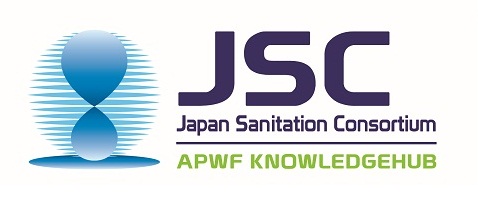
WATER KNOWLEDGE HUB FOR SANITATION
> for the improvement of sanitation conditions in the Asia-Pacific region
► NEWS & EVENTS
JSC Thematic Session at 8th WWF
mllmmTheme 'URBAN' ‒ Session 4C1:
mllmmREUSE TECHNOLOGIES: CAN WE HANDLE INNOVATION?
Session date & time: Wednesday 21 March 2018, 14:30-16:00
Session venue: Room 27, Ulysses Guimarães Convention Center - Brasilia, Brazil
Session organizers (members & organizations):
- Mr. Pierre Flamand, Japan Sanitation Consortium - JSC (session leader)
-lMr.lRenato Giani Ramos, Brazilian Association of Sanitary and
iiEnvironmental Engineering - ABES (session chair)
- Mr. Luís Marinheiro, AST – Environment Solutions and Services, Lda. (Portugal)
Session overview: Water reuse isn’t the future – it is the present. But are we ready to unleash this innovation that promises to transform our relationship with water? This session presented some of the technologies that can be implemented for reuse, rainwater harvesting, and desalination. Case studies showed how these innovative technologies and approaches can diversify sources of water while at the same time decreasing costs, protecting human health, and increasing resilience of communities. In the session was discussed the importance of investing in human capacity and the need to integrate systems for successful reuse.
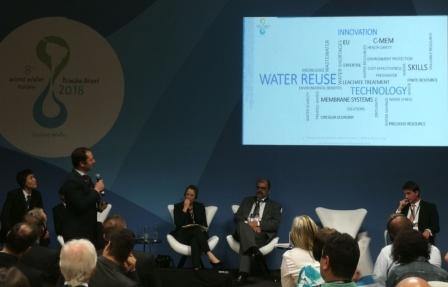
Above: Panel presentation
Key messages from each speaker:
The main discussion points presented by each speaker are as follows:
Opening remarks:
[Mr. Pierre Flamand, Japan Sanitation Consortium]
"There are considerable opportunities to make use of different sources of water for purposes such as irrigation, toilet flushing or filling up a groundwater basin, which can provide massive environmental benefits while decreasing water scarcity and stress in sensitive ecosystems. Technologies for water reuse and successful examples are already available, however applications at local or national levels are still limited. In this session will be shown through presentations different applications of water reuse in several regions of the world, which will be followed by a panel discussion that will reflect on how to expand the reuse of water globally."
Presentation 1: Water Reuse in Japan
[Mr. Hiromasa Yamashita, National Institute for Land and Infrastructure Management (NILIM); Ministry of Land, Infrastructure, Transport and Tourism (MLIT); Japan]
"The average annual precipitation in Japan is almost twice as that of the world average (800 mm), while the country is characterized by a large population living in a small area. There were different drought episodes over the last 40 years in Japan, particularly in Fukuoka City in 1978. From the severe drought of 1978 until 2014, the reuse of water increased from 50 million m3/year to 215 million m3/year by using new reuse applications, such as creating a double piping system in buildings and by using the reverse osmosis technology for recreational use. The rate of reclaimed wastewater in Japan is 1.5% (FY 2014), representing a total amount of 14.7 billions m3/year. Water is reused for landscapes, river flow augmentation, snow melting, direct industrial use, irrigation, toilet flushing and recreational use. Water reuse for toilet flushing is used for example in Yokohama City in a football stadium and at event sites. A project of reclaimed wastewater (rich in nutrients) used in aqua/agriculture has also been developed in Saga City, which help enhancing the local economy."
Above: Presentation of Mr. Hiromasa Yamashita
Presentation 2: National Water Reuse Plan and Policy in Brazil
[Mr. Ernani Ciraco de Miranda, Ministry of Cities; Brazil]
"Rainwater in Brazil is reused for agriculture and animal farming, but there are also projects for desalination plants. It is now necessary to create a national plan with scheduled implementation for water reuse. A reflection has been launched by the government on the policy for water reuse parameters. Five large regions in Brazil have a good potential for water reuse. In association with water reuse, the establishment of a circular economy is important. For non-potable use, a quality card is being developed with 3 quality levels from secondary, tertiary and more advanced treatment. In addition, a project is being formulated for the control and regulation of water reuse in agriculture, depending on the technology used. There is now an intensification of the discussions and negotiations with the users, the professionals involved in drinking water treatment and the industrials."
Above: Presentation of Mr. Ernani Ciraco de Miranda
Presentation 3: Water Recycling for Non-potable and Potable Purposes on Multiple Scales
[Mrs. Paula Kehoe, San Francisco Public Utilities Commission; USA]
"The San Francisco Public Utilities Commission (SFPUC) supplies quality water every day to 2.7 million people. The SFPUC approach to recycled water is to promote multiple scales - centralized and decentralized solutions for potable and non-potable applications. Water from groundwater is already injected into drinking water reservoirs. Water is also recycled for the watering of green spaces, while in buildings water is currently recycled for non-potable uses. The SFPUC has implemented a Rainwater Harvesting Program for a few years. The program is focusing on collecting rainwater through rain barrels and cisterns for reuse in the residential setting. A 9-month pilot project has been launched recently to produce potable water from recycled water at building scale, using the most advanced purification treatment processes (UF, RO, AOP)."
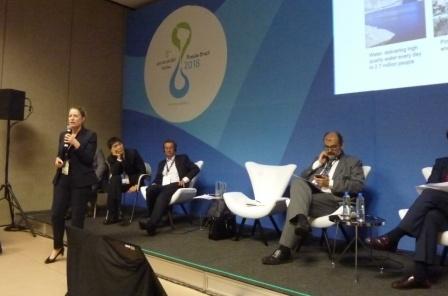
Above: Presentation of Mrs. Paula Kehoe
Presentation 4: Reuse Technologies, Urgency of Water Demands, Technological Evolutions and Costs
[Mr. Percy Soares, National Confederation of Industry (CNI); Brazil]
"There is an urgent need to promote water reuse in Brazil. A study was made in the region of Sao Paulo with different scenarios for water reuse and the costs associated with each scenario. One of the goals of the study was to identify the needs for water reuse for the principal industrial sites. In other parts of Brazil, such as the Northeast, water is scarce. There is also a shortage of sewerage systems and problems with wastewater treatment. The reuse of treated wastewater needs to be considered in such regions. The problem with water reuse is not the technology but how to reduce the costs for production and equipment. In order to do so, a national policy for water reuse needs to be developed."
Above: Presentation of Mr. Percy Soares
Presentation 5: Water Reuse in Europe and Case Studies on Reuse Technology for Non-potable Use
[Mr. Luís Marinheiro, AST - Environmental Solutions and Services, Lda.; Portugal]
"Across the EU, water shortages and droughts have increased dramatically in recent decades. As a result, about 11% of the population of the continent is affected by water scarcity. More than 40,000 million m3 of wastewater is treated every year, but only 964 million m3 is reused. The problem is growing and the EU is using up its essential water resources. However, member states are now taking actions. The advanced technologies applied for the production of reused water include reverse osmosis and membrane ultrafiltration. Modern landfill can be applied for leachate treatment as well as the reverse osmosis technology, which achieves excellent results. A mobile technology using membrane ultrafiltration (C-MEM) allows the purification and reuse of water in situ."
Above: Presentation of Mr. Luís Marinheiro
Panel discussion
Panelists: - Mr. Claudio H. Ternieden, Water Environment Federation - WEF
- Mr. Claus Homann, Aarhus Water Utility Ltd.; Denmark
- Mrs. Helene Kubler, CH2M; Brazil
- Dr. Marlos De Souza,
iiFood and Agriculture Organization of the United Nations - FAO; Italy
- Dr. Carla Laucevicius, Toth Research & Lab; Panama
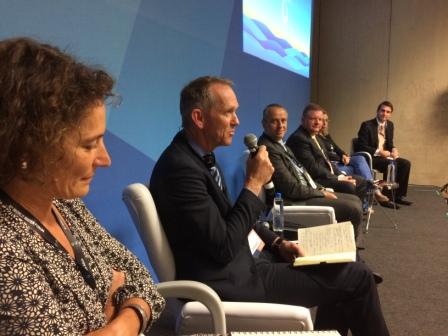
Above: Panel discussion
Messages from panel discussion:
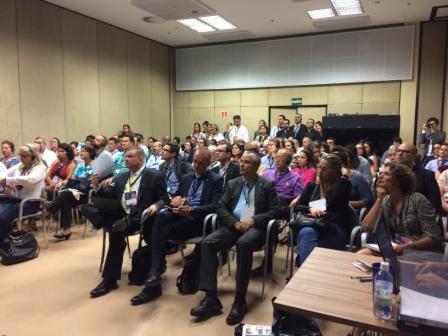
Above: Session audience
→ Report of the Session Outcomes
Above: Session participants